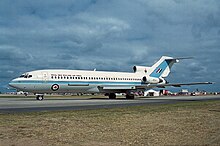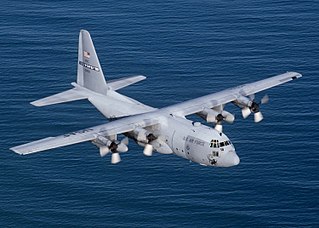
The Lockheed C-130 Hercules is an American four-engine turboprop military transport aircraft designed and built by Lockheed. Capable of using unprepared runways for takeoffs and landings, the C-130 was originally designed as a troop, medevac, and cargo transport aircraft. The versatile airframe has found uses in other roles, including as a gunship (AC-130), for airborne assault, search and rescue, scientific research support, weather reconnaissance, aerial refueling, maritime patrol, and aerial firefighting. It is now the main tactical airlifter for many military forces worldwide. More than 40 variants of the Hercules, including civilian versions marketed as the Lockheed L-100, operate in more than 60 nations.
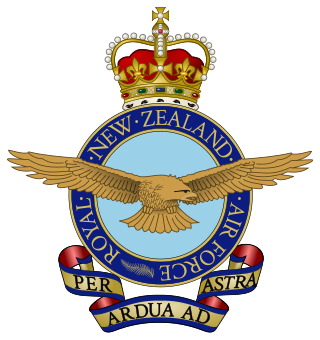
The Royal New Zealand Air Force is the aerial service branch of the New Zealand Defence Force. It was formed initially in 1923 as a branch of the New Zealand Army, being known as the New Zealand Permanent Air Force, becoming an independent air force on 1 April 1937.

The Lockheed Martin EC-130 series comprises several slightly different versions of the Lockheed C-130 Hercules that have been and continue to be operated by the U.S. Air Force and, until the 1990s, the U.S. Navy.
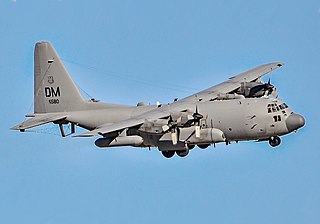
The EC-130H Compass Call is an electronic attack aircraft flown by the United States Air Force. Based on the Lockheed C-130 Hercules, the aircraft is heavily modified to disrupt enemy command and control communications, perform offensive counterinformation operations, and carry out other kinds of electronic attacks. Planned upgrades will add the ability to attack early warning and acquisition radars. Based at Davis-Monthan AFB in Arizona, EC-130Hs can be deployed worldwide at short notice to support U.S. and allied tactical air, surface, and special operations forces.
No. 42 Squadron is an active transport squadron of the Royal New Zealand Air Force (RNZAF). It was formed at Rongotai Airport (Wellington) in December 1943 to provide a communications service around New Zealand, initially using impressed civilian types. It was briefly officially disbanded in 1946, but its aircraft continued with general purpose operations at RNZAF Station Ohakea. When reformed, the squadron was equipped with various numbers of North American Harvard, Auster, Grumman Avenger, Airspeed Oxford, de Havilland Devon, North American P-51 Mustang and Douglas Dakota aircraft.

The Lockheed HC-130 is an extended-range, search and rescue (SAR)/combat search and rescue (CSAR) version of the C-130 Hercules military transport aircraft, with two different versions operated by two separate services in the U.S. armed forces.

No. 3 Squadron RNZAF is a unit of the Royal New Zealand Air Force (RNZAF). It currently operates NHIndustries NH90 and Agusta A109 helicopters. The squadron was initially formed as a territorial unit of the New Zealand Permanent Air Force in Christchurch in 1930. During World War II, the squadron served in the Pacific, undertaking patrol operations. In the early post war period, the squadron was converted to a Territorial formation flying fixed wing aircraft, but later converted to rotary wing aircraft, and returning to permanent status. Since then, personnel from the squadron have served in the Vietnam War, East Timor, Singapore, the Sinai, and the Solomon Islands.

No. 5 Squadron RNZAF is a maritime patrol and anti-submarine warfare squadron of the Royal New Zealand Air Force. It operates the Boeing P-8 Poseidon from RNZAF Base Ohakea. The squadron was formed during the Second World War and has since been in continuous operation. A number of maritime patrol aircraft have been operated by the squadron over the course of its existence including the Short Singapore, Consolidated PBY Catalina, Short Sunderland and the Lockheed P-3 Orion.

RNZAF Base Woodbourne is a base of the Royal New Zealand Air Force, located 8 km west of Blenheim.

RNZAF Base Ohakea is an operational base of the Royal New Zealand Air Force. Opened in 1939, it is located near Bulls, 25 km north-west of Palmerston North in the Manawatū. It is also a diversion landing point for civilian aircraft. The base's motto is Defensio per vires.

No. 84 Wing is a Royal Australian Air Force (RAAF) transport wing. Coming under the control of Air Mobility Group (AMG), it is headquartered at RAAF Base Richmond, New South Wales. The wing comprises No. 35 Squadron, operating Aliena C-27J Spartan transport Aircraft; No. 37 Squadron, operating Lockheed Martin C-130J Super Hercules medium transports; and a technical training unit, No. 285 Squadron.
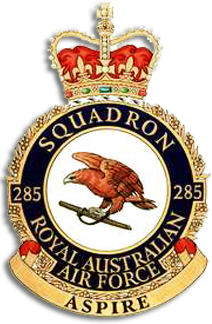
No. 285 Squadron was a Royal Australian Air Force (RAAF) training squadron. Controlled by No. 84 Wing, the squadron was formed in August 1999 to train the RAAF's Lockheed Martin C-130J Hercules aircrew and ground support staff. No. 285 Squadron did not control any flying aircraft but managed the flight simulator used for converting aircrew to the C-130Js operated by No. 37 Squadron. It was also allocated decommissioned Hercules airframes for training purposes, as well as flying aircraft from No. 37 Squadron when required. Throughout its existence, No. 285 Squadron was located at RAAF Base Richmond in the western suburbs of Sydney. The squadron was disbanded in December 2017.

The Lockheed Martin C-130J Super Hercules is a four-engine turboprop military transport aircraft. The C-130J is a comprehensive update of the Lockheed C-130 Hercules, with new engines, flight deck, and other systems.
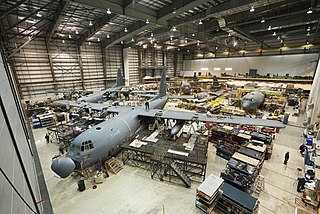
Cascade Aerospace Inc. of Abbotsford, British Columbia, Canada is a specialty aerospace and defence contractor, focused on providing long-term integrated aircraft support programs for Original Equipment Manufacturers (OEMs), military, government and commercial customers.

Orléans – Bricy Air Base is a French Air and Space Force (ALAE) base. The base is located approximately 6 miles (9.7 km) north-northwesst of Ingré near the city of Orléans; about 65 miles (105 km) south-southwest of Paris, France.

The Lockheed MartinKC-130 is a family of the extended-range tanker version of the C-130 Hercules transport aircraft. The KC-130J is the latest variant operated by the United States Marine Corps (USMC), with 48 delivered out of 79 ordered. It replaced older KC-130F, KC-130R, and KC-130T variants for aerial refueling. USMC reserve unit, VMGR-452 operated 12 KC-130T aircraft until May 2021; this was the last USMC reserve unit that operated the legacy KC-130s, completing the corps' transition to the more advanced Super Hercules.

Mangere Aerodrome, named after a nearby suburb, was the original home of the Auckland Aero Club. It is now the site of Auckland Airport. Mangere Aerodrome's claim to fame was as the arrival point for New Zealand aviator, and aeroclub member, Jean Batten's solo flight from the United Kingdom in 1936. The RNZAF requisitioned the aerodrome from 1939 until 1944, renaming it RNZAF Station Mangere. In 1961, the Auckland Aero Club moved to Ardmore aerodrome and Mangere Aerodrome closed. The new Auckland Airport opened in 1965.

The Royal New Zealand Air Force (RNZAF) is organised into a small number of flying squadrons and ground-based units. Most of the RNZAF's operational and training units are stationed at RNZAF Base Auckland and RNZAF Base Ohakea in the North Island. Several training and maintenance units are located at RNZAF Base Woodbourne in the South Island.
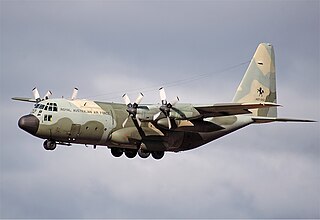
The Royal Australian Air Force (RAAF) has operated forty-eight Lockheed C-130 Hercules transport aircraft. The type entered Australian service in December 1958, when No. 36 Squadron accepted the first of twelve C-130As, replacing its venerable Douglas C-47 Dakotas. The acquisition made Australia the first operator of the Hercules after the United States. In 1966 the C-130As were joined by twelve C-130Es, which equipped No. 37 Squadron. The C-130As were replaced by twelve C-130Hs in 1978, and the C-130Es by twelve C-130J Super Hercules in 1999. No. 37 Squadron became the RAAF's sole Hercules operator in 2006, when No. 36 Squadron transferred its C-130Hs before converting to Boeing C-17 Globemaster III heavy transports. The C-130Hs were retired in November 2012, leaving the C-130J as the only model in Australian service. A further twenty C-130Js will be ordered to replace the current fleet.

No. 41 Squadron was a transport unit of the Royal New Zealand Air Force (RNZAF). The squadron was formed in 1944, and conducted transport flights in the south Pacific during World War II. It remained active after the war, and flew supplies to the New Zealand occupation force in Japan. Three crews from the squadron participated in the Berlin Airlift during 1948 and 1949, and one of its flights was temporarily based in Singapore from 1949 to 1951. From 1955 the entire squadron was stationed at Singapore, from where it participated in the Malayan Emergency, Indonesia–Malaysia confrontation and Vietnam War. Detachments of No. 41 Squadron were also based in Thailand from 1962 to 1965. The squadron was disbanded in 1977.


